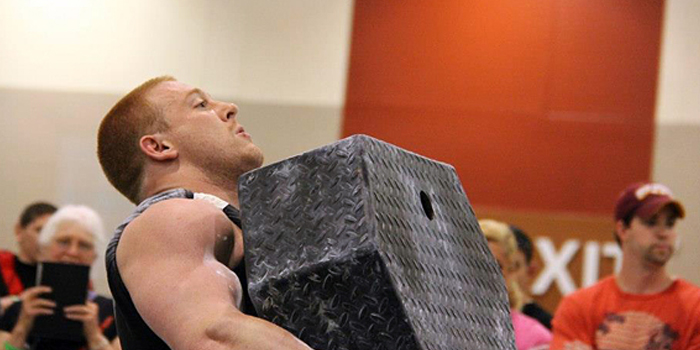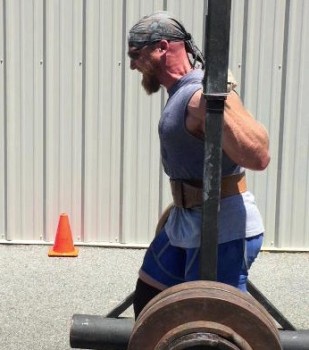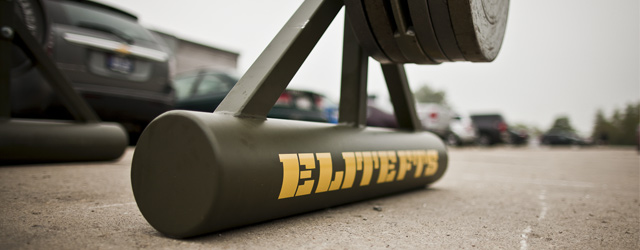
In order to take a scientific approach to one of the most difficult of strongman event, let’s break down all of the moving pieces of the yoke walk. Then we will utilize that breakdown to better build up and perfect it. The first, most important thing to examine is footwear. This will be different from person to person, but I recommend wearing something that is sturdy yet has a little bit of cushion. I find trail shoes meet this requirement best for me. You obviously wouldn’t wear something that is going to give out on you while you’re carrying the yoke, but something that is too stiff will lead to a lot of impact on your shins and could cause shin splints. If yoke is a weakness of yours, it should be trained with regularity. Getting shin splints every week would not be especially advantageous.
The next thing to look at is your legs. This should also be obvious, as the yoke walk is a moving event. When examining your stride, there are several things to consider:
- Start with small strides. Make sure the yoke is nice and stable before you even begin to move. As you start walking, set a pace and keep moving with it.
- There should always be two things going on with your legs at all times. I think people often miss the second one, so listen up. First, you should be pushing off your back foot in a heel to toe manner as hard as you can. Second, your front foot should be pulling you into your next stride. Think about performing a hamstrings curl to pull yourself forward.
- Walk quietly. Do not stomp. A great cue I have found for this is to imagine that you are walking on gravel trying not to make a sound. There is a certain strike pattern with the foot that comes to mind with this cue. That’s what you should use.
We can group a few things together, which we will call the stabilizers. In this case it would be your hips, which you want to keep as still as possible to prevent any lateral momentum from entering the equation. You should keep your hips moving as you see the speed walkers doing where they are able to keep their entire bodies almost motionless from the hips up, with their legs are moving at a rapid pace. Your abs, obliques, and low back extensors are holding you upright. They should also be forcefully pushing out against your belt in order to better brace the load they are bearing. There are a few breathing patterns that I have seen people use that you may want to try:
- Take one huge breath and finish with your breath held. If the yoke is light, that’s definitely an option. A heavy or long distance yoke could cause problems here.
- Breathe intermittently throughout the walk. This is a more difficult method, and here's why: Try squeezing your abs as hard as you can and maintaining tightness while at the same time breathing into your abdomen. It’s exceptionally difficult, isn't it?
- My favorite technique is this: squeeze your abs as hard as you can to push out against your belt and breathe in very short shallow breaths similar to how you would coach a woman in labor to breathe. This allows you to take in air without compromising any tightness.
The last thing to examine in the yoke walk is your upper body. There are a couple different things that can be going on here so I will break each one down separately:
- There is the squat bar technique which seems to be the easiest for newcomers to figure out. You place both hands under the bar as you would a squat bar, squeeze your shoulders together to keep your upper back tight, and then press up into the yoke as if you were trying to press it overhead. There can be problems with this method for some people, as it can be exceptionally difficult to control the forwards/backwards swinging of the yoke should you have a misstep.
- The second technique is to put your hands on the outside of the uprights. With this method, cup the uprights and pull in as hard as you can. This will activate your rhomboids and lats — big muscles with lots of force output. This will help control the swinging of the yoke.
- The third and final technique is probably the hardest to get into if you have any issues concerning external rotation of your shoulders. This technique involve getting your hands inside of the uprights fairly high up and pushing out against them. I have found this to be the way that works best for me because it seems to take out any of the slack in the uprights and allows me to feel like I have control of the entire implement moving forward.
With all of these technique, it is advantageous to have a big, thick, strong upper back and traps to provide a shelf for the yoke to sit on.
Now that we’ve broken down the yoke into its key components, let's look at how you can train in the gym to improve it. Plenty of upper back work, such as face pulls and pull-aparts, will help. Rows and deadlifts are also very important to get a strong, thick back. There is no alternative to rows and deadlifts for back development. The next thing I would recommend is doing regular reverse hypers with as heavy a weight as you can control. This does not mean swinging the weight recklessly. Use a weight that you can control your reps to completion with your glutes and back extensors. This very closely relates to the stride you take with the yoke.
I’m going to have to go against the grain and say I don’t think that squatting is as helpful with the yoke as most people make it out to be. I have seen pro strongmen that cannot squat 500 pounds run with 900 pound yokes while seeing guys that could squat 600-700 pounds getting buried by a 700 pound yoke. I do think that improving your squat will help with the squat but I don’t necessarily think being a great squatter will make you a great yoker. I also thinking squatting heavy regularly could prevent you from being able to train the yoke itself the way it ought to be trained. If I had to choose, I would say front squat helps with the yoke the most. If I have not been front squatting for a period of time, whenever I go back to it I am quickly reminded how weak my abs have gotten. Front squat is king of the squat when it comes to anterior core development. I should add that I do think SSB squats help to develop your core almost as much, so if you’re one of those guys that cannot front squat heavy because of wrist mobility or blacking out, the yoke bar is a reasonable substitution.
The best way, bar none, to get better at the yoke is to do it...a lot. By "a lot," I'm talking three out of four weeks in a training protocol. If you don’t have any contests coming up, it’s not a bad idea to do a lot of sets of yoke, with only one other event on your event days. If you have the luxury of doing it this way, a great way to set up your training is like this:
Yoke Training Tip During This Cycle: I often see people pumping their hips before they pick up a heavy yoke. This wastes 1-2 seconds and can actually cause the yoke to swing on you from the get-go. Instead, you need to be pushing up with 90% of the force it will take to lift the yoke then as soon as you get a start command drive your heels down through the ground and lock your hips out. This way is much faster and will shave some much needed decimals.
After one cycle through this program, repeat it and try to either increase 20-30 pounds from the last time you did the same scheme. Alternatively, you can keep the weight the same and decrease your time by 1-2 seconds. Yoke is always going to be a timed event, so I highly recommend timing every set possible to get yourself used to moving quickly. One place I find people making mistakes with the most frequently is they get so consumed with what the weight will be at their contest that they forget the most basic concepts of training. If you had an 800 deadlift in a contest but knew your max was 750, would you just continue to do sloppy ugly singles with 750 to improve your deadlift? Of course not. So why would you think that methodology would work with yoke? You have to make sure you can smoke a 500 yoke before you move on to a 600 yoke. Being able to see that it takes many steps to reach the peak is a critical aspect of strongman training. Be patient and use this technique for six months and you will be surprised at how far you can progress in that period of time.












